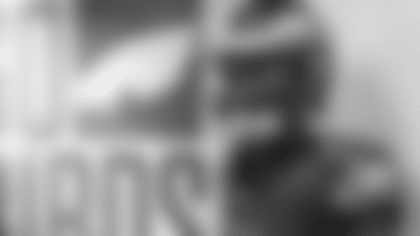This is the cover story of the October 21 edition of**Gameday Magazine**, which will be available this weekend at the Eagles Pro Shop at Lincoln Financial Field and local ACME Supermarkets.
In my 15 seasons of covering the Philadelphia Eagles, I've been able to witness some of the greatest players ever to wear the uniform.
Some of them are in the Eagles Hall of Fame, but only one is enshrined in Canton, Ohio – Brian Dawkins.
Dawkins is my all-time favorite Eagle. And it's not even close. I'm sure many of you reading this are nodding in agreement.
Of course, there's the production on the field. How many players can say that they had such an impact on the sport that they changed the way their position was utilized? Once the last line of defense, safety became a playmaker spot thanks to Dawkins. Just in his time with the Eagles, Dawkins had 34 interceptions, 32 forced fumbles, 21 sacks, 16 fumble recoveries, and four total touchdowns.
How many players in NFL history have 30 interceptions and 20 sacks? Five. And Dawkins is one of them.
In the years to come, safeties like Troy Polamalu and Ed Reed will get into the Pro Football Hall of Fame. They have Dawkins to thank for paving the way.
It's not just about the numbers when it comes to Dawkins. There are the moments.
In Week 3 of the 2008 season, the Eagles took down Pittsburgh Steelers quarterback Ben Roethlisberger eight times. Dawkins sealed the 15-6 victory when he flew like Superman to strip the ball from Big Ben and recover the fumble.
There's the last home game of the 2008 campaign, the final day of the regular season. The Eagles' chances of getting in the postseason were bleak after an upset loss in Washington the week before. A laundry list of results had to go in the Eagles' favor, just for the game against the Dallas Cowboys to mean anything. Of course, as we all know, by the end of the 1 p.m. games the winner of the Cowboys-Eagles showdown earned the final invite to the playoffs. Win or go home. Against Dallas. At Lincoln Financial Field, no less!
Dawkins battled a horrific ear infection all week leading up to the game, but he was never going to miss this contest.
Not only did he play, but Dawkins also had one of the greatest games of his career. He forced two fumbles that were both returned for touchdowns in the 44-6 rout.
Of course, there's the hit. The hit. When you think of Dawkins and a bone-crushing tackle, there's one play that immediately comes to mind – the 2004 NFC Championship Game blow delivered to Alge Crumpler. You might forget that Crumpler managed to hold on to the ball, but the message was sent. After three straight defeats in the NFC title matchup, the Eagles were not going to be denied.
There have been plenty of players who shined in big moments, but none connected with the fans the way Dawkins did. If you needed any sort of reminder, just watch Dawkins' Hall of Fame speech from August. Eagles fans turned the crowd at Tom Benson Hall of Fame Stadium into a sea of midnight green.
Eagles fans love defense. That was cemented during the Buddy Ryan era and the Gang Green defense of the late 1980s and early '90s. Dawkins was the continuation of that.
There's also the unbridled energy with which Dawkins played the game. A quiet, Christian man who led by example during the week transformed into an alter ego – named Weapon X – on gameday. He had deep conversations with the football. He galvanized his teammates with his pregame speeches. His crawl out of the tunnel before being shot out of a cannon onto the field? You would have believed he was a superhero out of a comic book and not an NFL player.
Dawkins said it time after time again. He played the game the way he thought that the fans would if they ever had the chance to be on the field.
A second-round pick of the team in 1996, before the winning seasons under head coach Andy Reid, No. 20 understood the unique dynamic between the fans and this football team. Dawkins embraced them by living under the simple motto of treating others the way he wanted to be treated. He knew that the blue-collar fans were spending their hard-earned money to see the Eagles play and he wanted to give them a show.
Dawkins was perfect for Philadelphia but his road there was far from an ideal one. And while Dawkins was the one on the pulpit at the Pro Football Hall of Fame over the summer accepting his place among the giants of the game, it took a team to get him there.
A native of Jacksonville, Florida, Dawkins took to football in his youth because he had a lot of energy – no surprise there – and it kept him out of trouble. He also had a love for basketball, but realized during his time as a student at Raines High School that football would be his avenue to college. Plus, he had an older brother, Ralph, who was a star running back at Louisville to look up to as a role model.
Dawkins recalls when recruitment letters started coming in from colleges. Raines High School has produced quality football talent over the years, including Eagles Hall of Fame wide receiver Harold Carmichael. But when the first letter came for Dawkins from the University of Notre Dame, the school's principal brought it into class and handed it to Dawkins in person.
Dawkins dreamed of going to the University of Florida. He had the Gator Chomp down and was planning out his defensive celebrations. However, academics weren't a priority at the time. Dawkins met with Gators defensive coordinator and defensive backs coach Ron Zook and was told that the scholarship offer was being pulled. Dawkins was good, but not good enough to wait for. Also in the room for that meeting was Dawkins' girlfriend, Connie, who would later become his wife.
Inspired to overcome the setback, Dawkins fixed the grades, but the problem was there wasn't a school waiting for him. Louisville showed interest, but Dawkins thought it was only out of respect for his brother. South Carolina had an offer on the table at one point, but when Dawkins tried to reach someone to accept it, he couldn't get a hold of anyone on the phone. His close friend, high school teammate, and superstar recruit Patrick Sapp told Dawkins not to waste his time with South Carolina. Sapp, who was committing to Clemson, called the recruiting coordinator and said that he and Dawkins were a package deal. If you wanted Sapp, you had to take Dawkins as well.
For a long time, Dawkins thought that Clemson wanted him on his own merit. About five years ago, Dawkins learned how Sapp helped get him a scholarship to Clemson.
Once on campus, Dawkins dominated – first on special teams then as a defensive standout by his sophomore season.
Leading up to the 1996 NFL Draft, Dawkins had no clue that the Eagles coveted him saying the team had an "outstanding poker face."

Philadelphia presented a wide array of challenges both on and off the field. He and Connie were newlyweds, and had a young son, Brian Jr. Dawkins was trying to adjust to being a professional football player, a new husband and father, and a provider for his family.
It was a lot. There were demands on him from other family members who assumed the NFL meant riches beyond belief. He didn't want to let anyone down. He also didn't have an outlet, so he went into a deep depression and contemplated suicide.
After his rookie season, Dawkins sought the help he needed thanks to his wife and his defensive coordinator at the time, Emmitt Thomas.
"Emmitt got me to recognize what I could do," Dawkins says. "I didn't see myself the way he saw me."
Dawkins relied on his deep religious faith to pull him out of despair. He eventually turned his life around. Two years later, his career took off under the guidance of Jim Johnson, who was hired to be the new defensive coordinator under Reid in 1999.
It was a special relationship, as Dawkins knew what he was capable of and Johnson was able to unleash that potential. Both strong and silent men, Johnson was demanding in how he wanted the job done, but Dawkins was a willing and able student. The Eagles consistently fielded one of the best defenses in the league and earned a trip to the Super Bowl in the 2004 season.
2008 marked the end of an era. Dawkins left the team following a run to the NFC Championship Game to finish his career with Denver, a decision the Eagles should have never allowed to happen. Johnson passed away in 2009 after a bout with melanoma.
Dawkins returned to Philadelphia as a front office executive in 2016 and was a part of the team that brought home the franchise's first Super Bowl title. On the eve of that glorious victory, Dawkins received the news that he would be a part of the Pro Football Hall of Fame's Class of 2018.
On Sunday, as the Eagles host the Carolina Panthers at Lincoln Financial Field, Dawkins will be honored at halftime as he receives his ring from the Hall of Fame. The stadium will erupt once again when the legend walks out onto the field. While Dawkins has transitioned from helping players on the football field to aiding people in all walks of life, his profound influence on the fans, the game, and the franchise is a lasting fixture that all of us can take pride in.






















